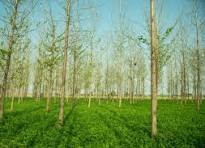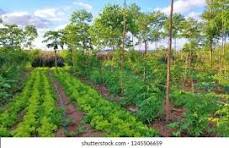
Preserving Biodiversity Alongside Sustainable Farming Through Agricultural Forestry Publish Date : 16/04/2025
Preserving Biodiversity Alongside Sustainable Farming Through Agricultural Forestry
Dr. Virendra Singh Gahalan
Introduction: Balancing Nature and Agriculture
As the demand for food, fiber, and natural resources grows, conventional agriculture often compromises with biodiversity. Yet, Agricultural Forestry offers a transformative solution, blending productivity with ecological harmony. Defined as a system integrating tree crops, meadows, domestic animals, living fences (hedges and windbreaks), and perennial plants, it mirrors natural forest ecosystems to produce food, materials, and specialty products (Agronomic Terminology, Indian Society of Agronomy, 2nd Edition, New Delhi). This approach not only sustains human needs but also restores biodiversity, enhances resilience on degraded lands, and supports livelihoods in challenging agro-ecological conditions.
By replicating forest dynamics, agricultural forestry reimagines farming to preserve ecosystems while meeting economic goals. This bulletin explores its potential to foster sustainability, empower communities, and generate income, particularly on problematic soils.
Core Principles of Agricultural Forestry
Agricultural forestry thrives on diversity and adaptability. Its key features include:
1. Plant Diversity: Incorporating medicinal, aromatic, and high-value industrial plants alongside traditional crops boosts income and employment, especially on marginal lands.
2. Tailored Crop Selection: Matching species to land-use capabilities ensures ecological and economic success, with pooled harvests enhancing market viability.
3. Microclimate Optimization: Thoughtful designs leverage shade, humidity, and windbreaks to maximize production in unique locales like hilly regions.
4. Community Self-Sufficiency: Local production of food, fodder, timber, and specialty crops reduces reliance on external resources.
5. Protected Cultivation: Small, well-lit areas for specialty crops capitalize on microclimatic advantages, ideal for high-value yields.
6. Perennial Vegetation: Afforestation with hardy trees, shrubs, and creepers—resistant to animal damage—increases cover and supports cash crops.
Benefits to Biodiversity
Unlike monoculture farming, which depletes soils and displaces wildlife, agricultural forestry nurtures ecosystems by:
- Promoting diverse flora and fauna through mixed planting.
- Preserving habitats with living fences and perennial cover.
- Favoring hardy, native species that maintain ecological balance.
This system yields natural products—essential oils, herbal drugs, fatty acids—while safeguarding biodiversity, making it a win-win for nature and farmers.
Economic Potential: Value-Added Products

Agricultural forestry unlocks opportunities for small and medium enterprises (MSMEs) through medicinal and aromatic plants. Marketable products include:
1. Planting Materials: Seeds and propagules for expanding cultivation.
2. Crude Drugs: Dried plant parts (leaves, bark, roots) for national and global markets.
3. Herbal Powders: Safe options like ashwagandha, triphala, and stevia for wellness markets.
4. Herbal Teas: Powdered herbs in tea bags, a trend led by nations like China with over 200 varieties.
5. Beverages: Herbal juices, sherbets, and beers (e.g., nannari) with growing appeal.
6. Aromatic Concentrates: Essential oils, hydrosols, and oleoresins for cosmetics and therapeutics.
7. Bakery Innovations: Herbal-infused, sugar-free sweets and chocolates.
8. Extracts: Standardized phytochemical extracts for global trade.
9. Phytochemicals: Pure compounds (alkaloids, flavonoids) for pharmaceuticals.
10. Plant Drugs: Traditional medicines (Ayurveda, Siddha) from plant sources.
11. Cosmetics: Herbal soaps, hair oils, and aloe-based products.
12. Nutraceuticals: A rising sector for health supplements.
13. Pesticides: Natural pest repellents with future potential.
14. Byproducts: Rural enterprises utilizing waste for biofertilizers or crafts.
Implementation: Simplifying Complexity
The success of agricultural forestry lies in micro-planning at the household level. By simplifying its complexity, small farmers can adopt it through:
- Selecting resilient species suited to local conditions.
- Setting up small-scale processing units for value-added products.
- Training in cultivation, processing, and marketing.
This approach drives impactful change in specific Agro-Ecological Situations (AES), enhancing biodiversity and livelihoods.
Conclusion: A Sustainable Future

Agricultural forestry redefines farming as a partner to biodiversity, not a threat. By merging ecological resilience with economic opportunity, it offers a lifeline for degraded lands and rural communities. From herbal teas to nutraceuticals, its diverse outputs empower MSMEs while preserving ecosystems. As environmental pressures mount, this system shines as a model of sustainability—proving agriculture and nature can thrive together.
For guidance on species selection or implementation, contact your local agricultural extension office or biodiversity network.
लेखक: डॉ. वीरेन्द्र सिंह गहलान, सस्यविद, Ex. Chief Scientist, CSIR-IHBT, Palampur Himachal Pradesh.


